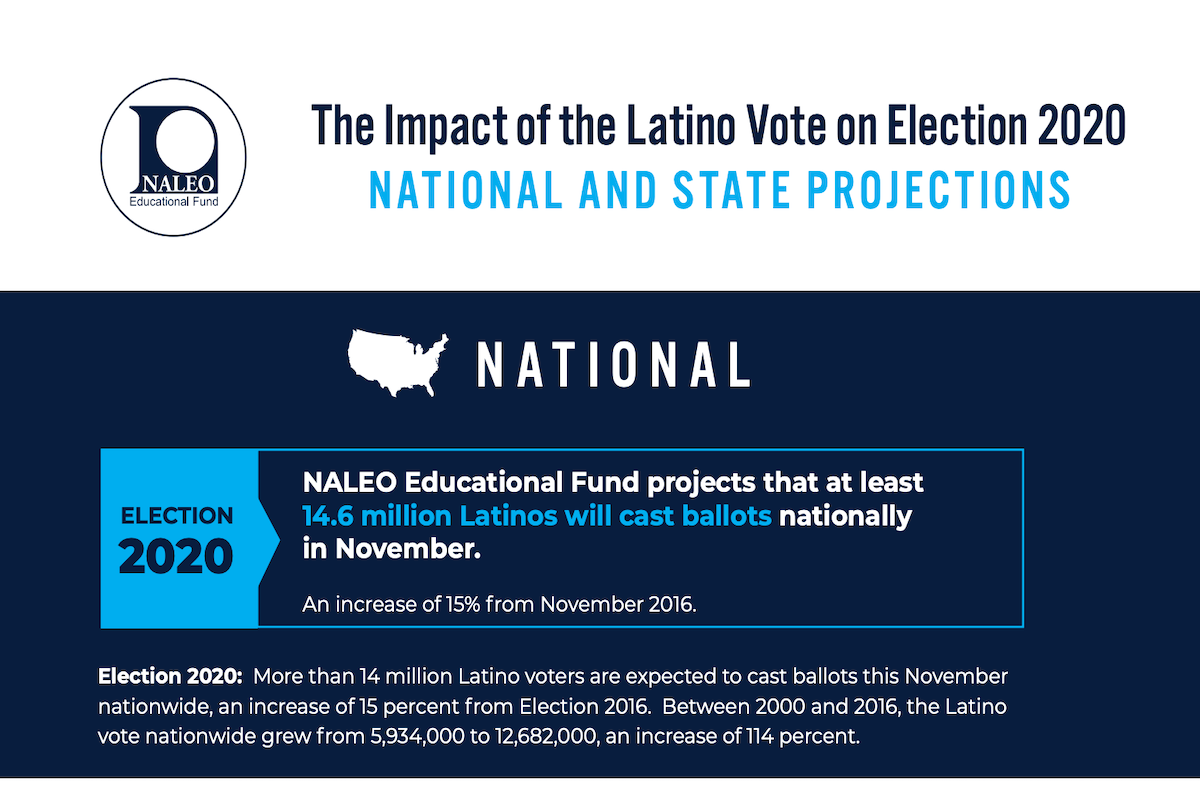

Stating that it would mark a 15 percent increase in U.S. Latino voters from 2016, an analysis shared Wednesday by the National Association of Latino Elected and Appointed Officials (NALEO) Educational Fund said that at least 14.6 million U.S. Latinos are predicted to vote during the November 2020 elections.
NALEO Education Fund also provided projections for some states:


The organization, however, noted that the current COVID-19 pandemic could impact estimates.
“Latino voters will play a decisive role in critical races throughout the country in 2020,” Arturo Vargas, Chief Executive Officer at NALEO Educational Fund, said in a statement. “And while the Latino community will have a sizable impact in various states, it is paramount that obstacles to voting do not hinder our community’s full potential for participating in our democracy. For many elections now, Latino voters have been concentrated in states that were not traditionally considered as battlegrounds. That is now changing with states like Arizona and Texas being sought after by both major candidates for president, making it possible for Latino voters to vote in even higher numbers than what we are estimating today. We recognize, however, that factors like COVID-19 could have a significant impact on voting and registration, as well as trends in naturalization processing and approvals this year. There are very real factors that put the Latino community at risk of lower voter participation rates.”
In addition to the overall voter estimates, NALEO Education Fund released a Latino Voters at Risk: Barriers to Latino Voter Turnout Amid COVID-19 report.
“In this publication, we identify and describe the possible negative impact on Latino voters as a result of the COVID-19 pandemic, in hope that this analysis will help voters, election administrators, and non-profit democracy advocates plan interventions to ensure against any further disruption of the right to vote,” a NALEO Education Fund release stated.
The organization also shared several findings from that report:
Latino Voters at Risk: Barriers to Latino Voter Turnout Amid COVID-19
- Disproportionate Impacts of COVID-19
- Data consistently show that Latinos are more likely to suffer severe health and economic consequences from the pandemic than non-Hispanic Whites, including higher rates of death, illness, hospitalization, and residential instability. Economic and residential stability disparities were associated with lower voter turnout before the pandemic and will exacerbate the challenges Latinos face in Election 2020.
- Voter Enthusiasm
- Polling by research firm Latino Decisions suggests that Latino voter enthusiasm has declined since the onset of the pandemic. In its February 2020 Univision Noticias/Latino Community Foundation poll, Latino Decisions found that 73 percent of Latinos nationwide indicated that they were almost certain to vote, and 12 percent indicated that they would probably vote. In contrast, in the April 2020 SOMOS poll, only 60 percent of Latinos indicated that they were almost certain to vote, and 15 percent indicated that they would probably vote.
- Voter Registration
- As a result of the pandemic, DMVs and other public agencies have closed or reduced their services. Given that large numbers of Latinos traditionally report having registered to vote at these agencies, these closures will make registration more difficult.
- Political science research has also consistently found that reaching Latinos in public settings or through person-to-person contact are among the most effective ways to register Latino voters, voter registration methods that are now infeasible given the realities of COVID-19.
- Voting Options
- While many jurisdictions are making vote-by-mail (VBM) more accessible to all voters and promoting it as the primary method of casting ballots for Election 2020, research by NALEO Educational Fund and other researchers indicate that in some states, Latinos tend to have lower VBM usage than the overall population.
- Election administrators appear to be maintaining some level of in-person voting, but there will be significant changes in policies and practices which could create obstacles to Latinos casting in-person ballots.
- Election administrators looking to expand voting sites may find fewer sites available that are able to accommodate social distancing and frequent sanitation practices. They may also experience challenges recruiting poll workers, many of whom have traditionally been older adults who are now one of the most vulnerable populations to COVID-19.
- Information and Misinformation
- Some research suggests that Latino concerns about the trustworthiness of election systems and misinformation may affect their willingness to vote.
- Latinos who lack access to online information may thus lack access to reliable information provided by jurisdictions and community organizations.



[…] there has been at least 25 deaths of transgender or gender non-conforming people, according to a report from the Human Rights Campaign (HRC). It is the highest number reported since 2003, the first year […]
[…] August, NALEO predicted that at least 14.6 million Latinos would vote this election […]